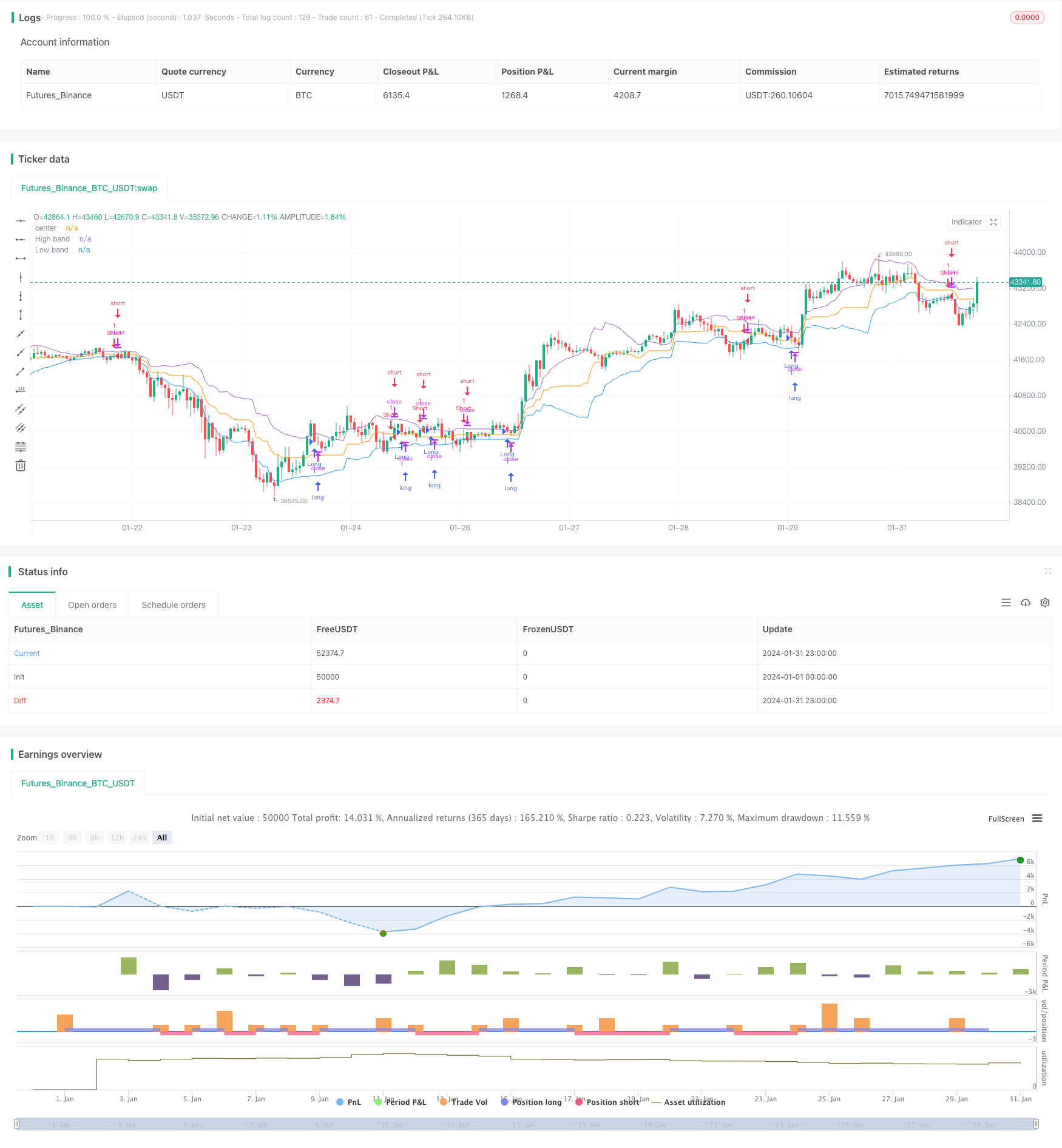
概述
本策略基于动态通道和均线的趋势跟踪原理设计。它计算价格的动态通道,通过通道上下轨判断价格趋势方向,结合均线滤波价格离散度,产生交易信号。该策略适用于中短线趋势交易。
原理
该策略主要基于以下原理:
计算动态价格通道。通过最高价和最低价计算通道中线,通道上轨为中线+价格离散度均线,下轨为中线-价格离散度均线。
判断趋势方向。当价格上穿上轨时,定义为看涨;当价格下破下轨时,定义为看跌。
滤波噪音。使用一定周期的价格离散度均线,滤波价格随机波动带来的噪音。
产生交易信号。看涨时,在该周期收盘价低于开盘价时产生买入信号;看跌时,在该周期收盘价高于开盘时产生卖出信号。
优势
该策略具有以下优势:
- 动态通道能实时捕捉价格趋势;
- 均线滤波能减少假信号;
- 结合趋势方向和K线实体方向产生交易信号,避免被套。
风险
该策略也存在以下风险:
- Params选取不当可能导致过度优化;
- 震荡盘整理时容易产生错误信号;
- 无法预测价格剧烈波动。
对应解决方法:
- 严格的Params选择和测试;
- 增加过滤条件,识别震荡盘整理;
- 设置止损止盈,控制风险。
优化方向
该策略可以从以下方面进行优化:
- 测试不同周期参数的稳定性;
- 增加VOLUME或波动度指标判断力度;
- 结合波段、通道等判断进入和退出。
总结
本策略整合动态通道和均线趋势判断的思想,在中短线捕捉趋势方向中表现不俗。但也存在一定局限性,需要进一步测试优化以适应更多市场情况。
策略源码
/*backtest
start: 2024-01-01 00:00:00
end: 2024-01-31 23:59:59
period: 1h
basePeriod: 15m
exchanges: [{"eid":"Futures_Binance","currency":"BTC_USDT"}]
*/
//@version=2
strategy("Noro's Bands Strategy v1.0", shorttitle = "NoroBands str 1.0", overlay=true, default_qty_type = strategy.percent_of_equity, default_qty_value=100.0, pyramiding=0)
//Settings
needlong = input(true, defval = true, title = "Long")
needshort = input(true, defval = true, title = "Short")
len = input(20, defval = 20, minval = 2, maxval = 200, title = "Period")
color = input(true, "Color")
needbb = input(false, defval = false, title = "Show Bands")
needbg = input(false, defval = false, title = "Show Background")
src = close
//PriceChannel 1
lasthigh = highest(src, len)
lastlow = lowest(src, len)
center = (lasthigh + lastlow) / 2
//dist
dist = abs(src - center)
distsma = sma(dist, len)
hd = center + distsma
ld = center - distsma
//Trend
trend = close < ld and high < hd ? -1 : close > hd and low > ld ? 1 : trend[1]
//Lines
colo = needbb == false ? na : black
plot(hd, color = colo, linewidth = 1, transp = 0, title = "High band")
plot(center, color = colo, linewidth = 1, transp = 0, title = "center")
plot(ld, color = colo, linewidth = 1, transp = 0, title = "Low band")
//Background
col = needbg == false ? na : trend == 1 ? lime : red
bgcolor(col, transp = 90)
//up = and trend == 1 ? 1 : 0
//dn = and trend == -1 ? 1 : 0
up = close < hd and trend == 1 and (close < open or color == false) ? 1 : 0
dn = close > ld and trend == -1 and (close > open or color == false) ? 1 : 0
longCondition = up == 1
if (longCondition)
strategy.entry("Long", strategy.long, needlong == false ? 0 : na)
shortCondition = dn == 1
if (shortCondition)
strategy.entry("Short", strategy.short, needshort == false ? 0 : na)